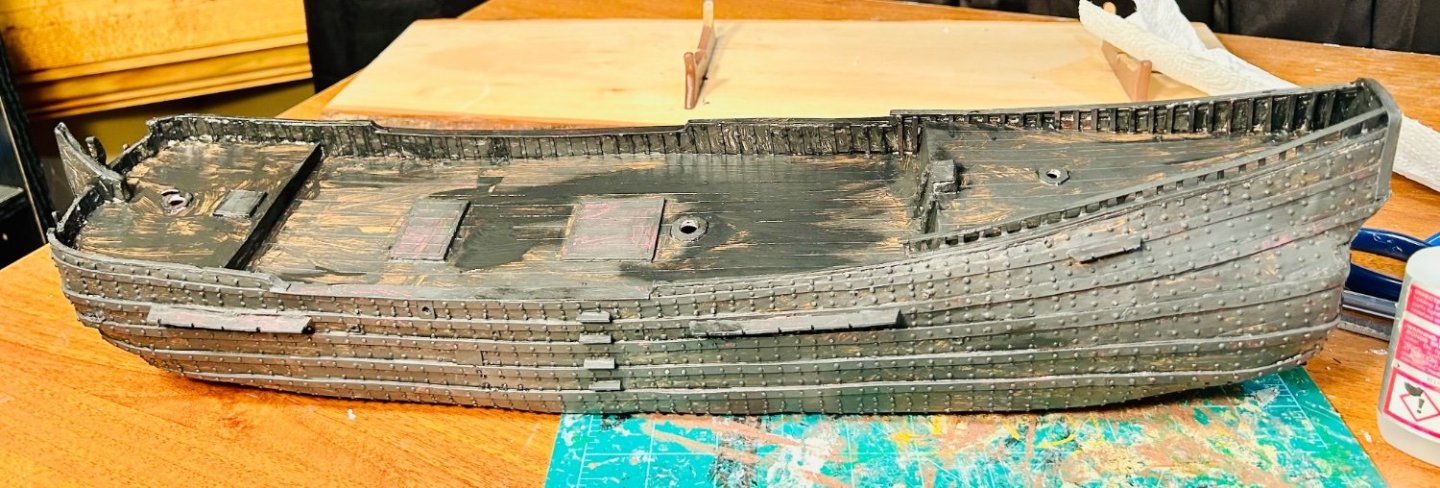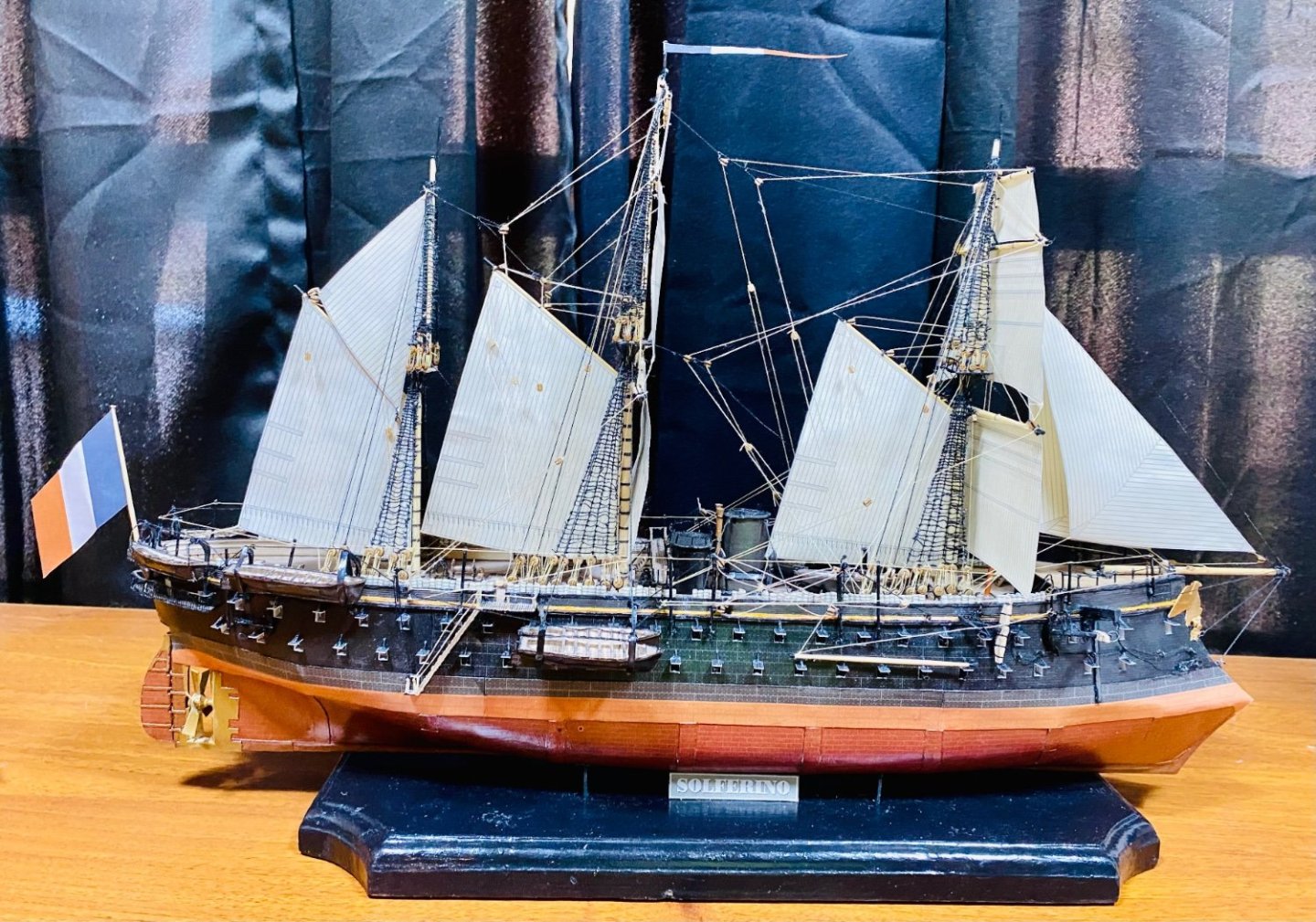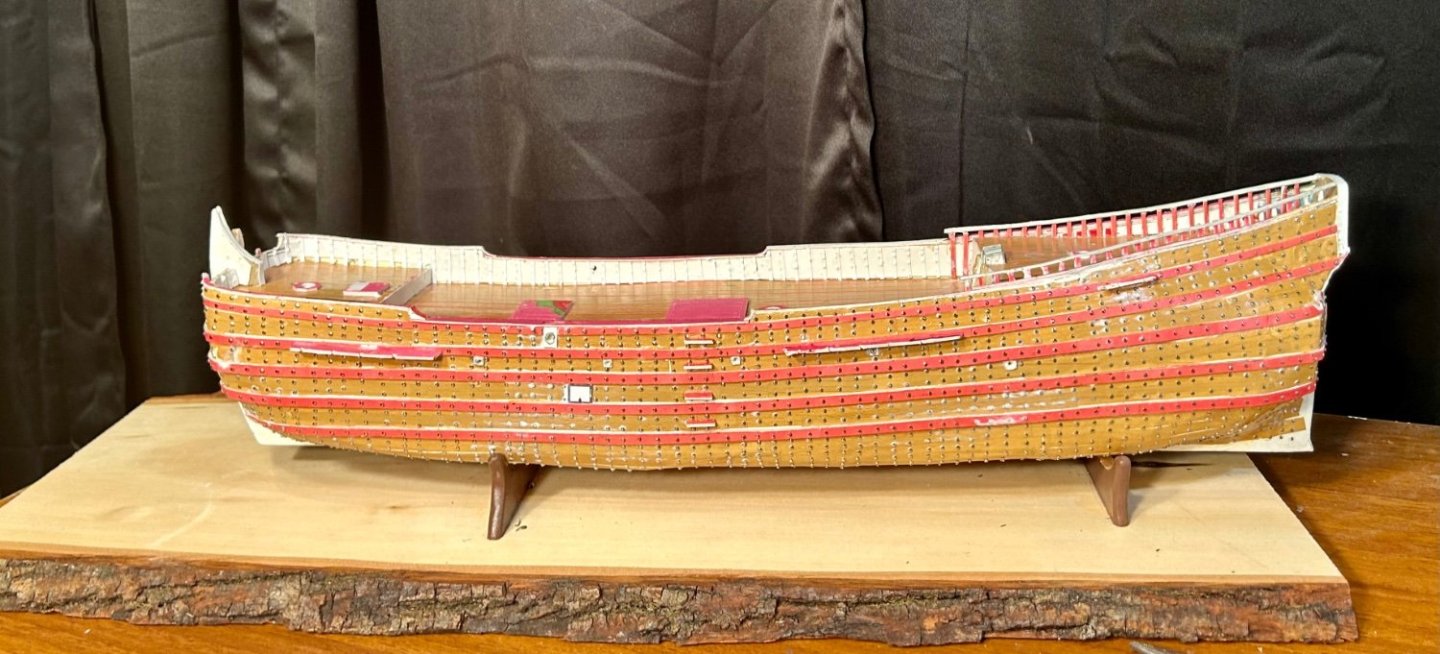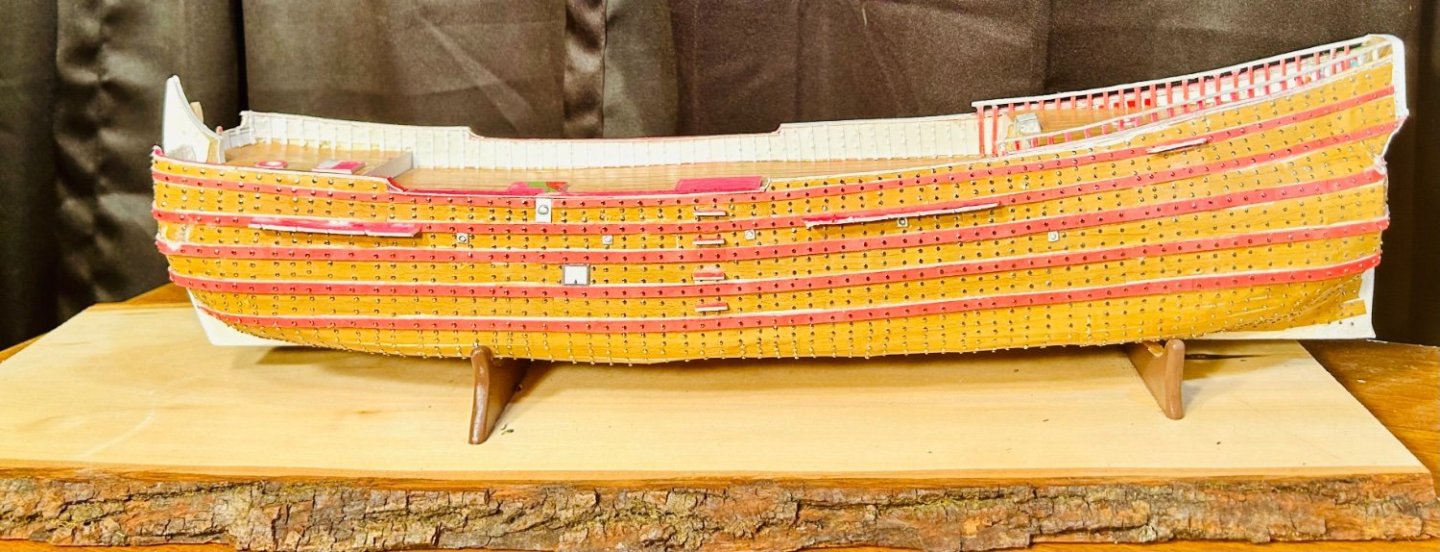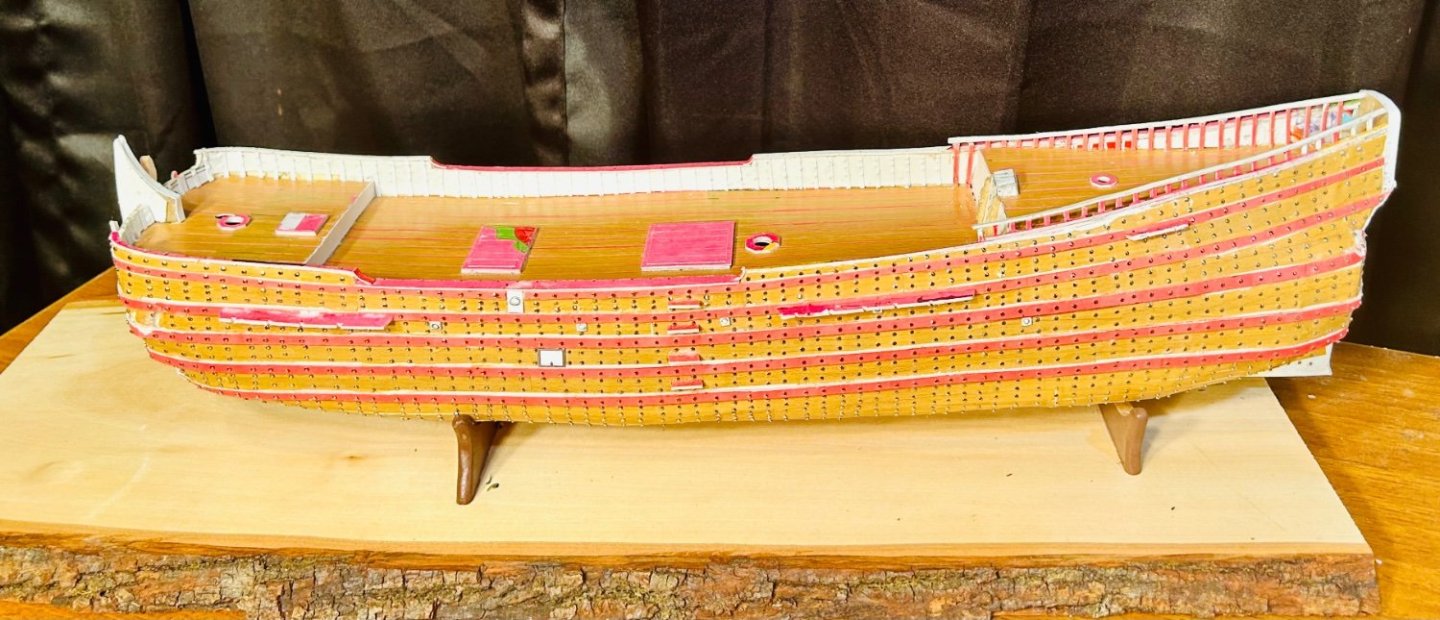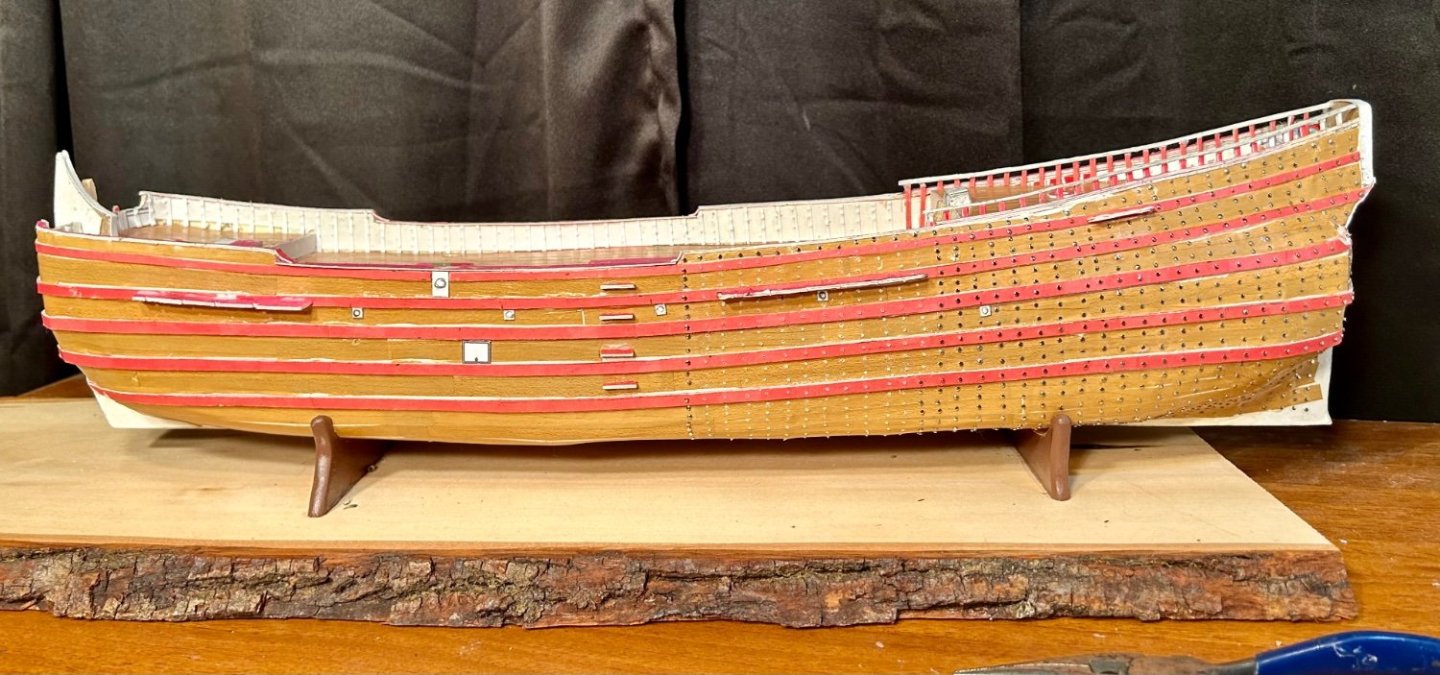
GrandpaPhil
NRG Member-
Posts
5,009 -
Joined
-
Last visited
Content Type
Profiles
Forums
Gallery
Events
Everything posted by GrandpaPhil
-
The first rigged model is the most difficult. Once you get your methods down, it all gets a lot easier. Then you keep refining your methods and trying new techniques with each model. Be careful handling blocks and deadeyes, use a wider jaw pair of tweezers with only the force necessary to hold the part to keep them from flying out of your hand.
-
The first coat of black is on: I need to let this first coat dry overnight and then I’ll add another coat tomorrow. For the non-wargamer painter, I am using mostly the same techniques that one would use to paint a Warhammer army. I begin by making the model all one color. I am using the black as a primer coat over a coat of acrylic sealant, which is what is making the black stick to the model. Using black as a primer assists me in doing several things. Firstly, it helps to give the model depth. Secondly, it helps makes the model look a little grungy, since this is a workboat. Lastly, it makes the colors that will be layered on stand out a little more. Once I get two to three layers of black on the model, I will begin drybrushing shades of brown on the model utilizing a makeup brush like I did my Sampang. I will begin with a dark shade of brown heavily applied and work my way through successively lighter shades of brown, successively lightly applied, finishing with a reddish brown on the hull, bulwarks and bulkhead. The deck will be finished with a lighter brown or dark tan, very lightly applied. Several of the wales, and trim, will be painted a dark burgundy. The waterline will then be marked off and the bottom painted a dingy white. Then all bolt heads above the waterline will be finished a medium gray, representing a faux metal iron. At this point I will paint the transom painting depicting a Dutch woman holding a platter of fresh baked bread, representing the wife of the guy who owned this ship (wife, guy and ship are completely fictional, but ship is supposed to be representative of the type in the middle to latter half of the 17th Century). Then the entire model will get sealed and construction will commence again. Later, after I finish the hull and paint the added details I will highlight the hull to give the impression of light hitting the ship.
-
Welcome!
-
Esther has all of her carriage bolts now, all 4200 of them: The holes are patched and should not be too noticeable. Either way, she will be painted in the style of a wargaming miniature, like all of my models, and will be weathered. This model has been a learning experience and I have been enjoying building it. Next up, I need to cut the holes for the scuppers and the large set of holes that the rigging passes through, and then it will be time to seal and paint the ship.
-
Welcome!
-
Hi from South Africa - novice alert!
GrandpaPhil replied to Ingo's topic in New member Introductions
Welcome! -
Hello from British Columbia!
GrandpaPhil replied to sixtythousandbees's topic in New member Introductions
Welcome! -
I punched another hole in the hull, in the bow area this time. I pulled the sides back out and applied a large amount of max hold CA, so we’ll see how that dries. That bottle of glue is getting old and therefore thickening up anyway, which is working to my advantage here. It’s a good thing that I am planning to make this ship a well used workhorse anyway, so a patch won’t be entirely out of place. Depending on how it looks after painting, I may rough up the rest of the model to make the ship look more well used.
-
I just made a major mistake. I punched a large hole in the bottom of the hull with a pair of needle nose pliers pushing a stuck stick pin into place. I pulled the “flaps” out, filled the hole with max hold CA and put another pin in place. Hopefully, once the glue dries and I paint the model it won’t be too visible. Fortunately, it’s on the bottom of a model of a flat bottomed ship.
-
Hello everyone, a beginner dips his toe.
GrandpaPhil replied to Gaz's topic in New member Introductions
Welcome! -
Welcome!
-
Welcome!
-
I got my new Excel razor saw blade today and realized that is the third blade I have gotten for that handle. I originally bought that razor saw in the mid 1990’s and model making has always been my go to hobby. That means that 2 blades lasted me nearly 30 years. I’ve definitely gotten my money’s worth out of them, especially with how much I build.
About us
Modelshipworld - Advancing Ship Modeling through Research
SSL Secured
Your security is important for us so this Website is SSL-Secured
NRG Mailing Address
Nautical Research Guild
237 South Lincoln Street
Westmont IL, 60559-1917
Model Ship World ® and the MSW logo are Registered Trademarks, and belong to the Nautical Research Guild (United States Patent and Trademark Office: No. 6,929,264 & No. 6,929,274, registered Dec. 20, 2022)
Helpful Links
About the NRG
If you enjoy building ship models that are historically accurate as well as beautiful, then The Nautical Research Guild (NRG) is just right for you.
The Guild is a non-profit educational organization whose mission is to “Advance Ship Modeling Through Research”. We provide support to our members in their efforts to raise the quality of their model ships.
The Nautical Research Guild has published our world-renowned quarterly magazine, The Nautical Research Journal, since 1955. The pages of the Journal are full of articles by accomplished ship modelers who show you how they create those exquisite details on their models, and by maritime historians who show you the correct details to build. The Journal is available in both print and digital editions. Go to the NRG web site (www.thenrg.org) to download a complimentary digital copy of the Journal. The NRG also publishes plan sets, books and compilations of back issues of the Journal and the former Ships in Scale and Model Ship Builder magazines.


